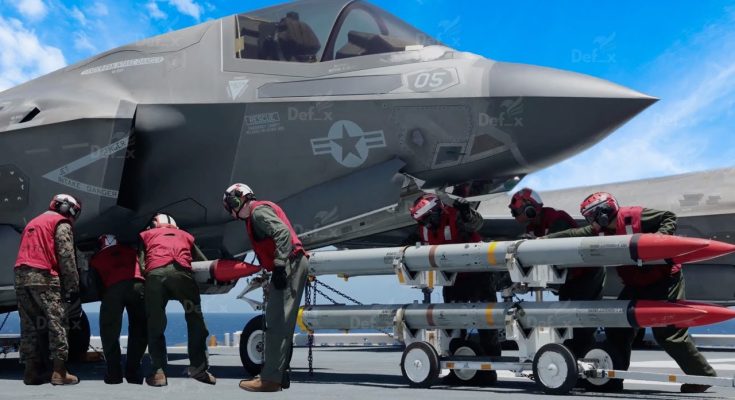The F-35B Lightning II is a game-changing aircraft for the U.S. Marine Corps and the U.S. Navy, especially for operations at sea. As a multirole stealth fighter, the F-35B is capable of short takeoff and vertical landing (STOVL), making it perfect for launch from amphibious assault ships, aircraft carriers, and other naval vessels. Its ability to carry a range of heavy payloads—ranging from bombs to missiles—while maintaining its remarkable agility, makes it an invaluable asset in modern warfare.
Preparing for the Mission
When the F-35B is deployed from a ship at sea, one of the most crucial steps is preparing the aircraft for takeoff. Unlike conventional aircraft that require long runways, the F-35B’s STOVL capability allows it to take off vertically or with a short roll. This makes it an ideal choice for operating from the confined decks of amphibious assault ships or smaller carrier decks where space is limited.
However, before the aircraft can perform its mission, it needs to be properly equipped with a variety of payloads depending on the operation. This is where U.S. Marine Corps and U.S. Navy personnel come in—responsible for loading the F-35B with the necessary ordnance.
Coordination on the Flight Deck
The process of loading heavy payloads onto the F-35B begins on the flight deck of the ship, where every movement is coordinated to ensure efficiency and safety. The flight deck is often bustling with activity as personnel work together to prepare multiple aircraft for launch or recovery. Every member of the team plays a specific role—aviation ordnance personnel, deck crew, pilots, and maintenance teams, among others.
When preparing the F-35B for a specific mission, the ordnance team, typically made up of aviation ordnance men, is tasked with loading bombs, rockets, and missiles onto the aircraft. These personnel work in tandem with the jet’s maintenance crew to ensure the aircraft’s weapons systems are functioning properly.
The F-35B is capable of carrying a variety of munitions. Under its wings, it can carry air-to-ground bombs such as the Joint Direct Attack Munition (JDAM) or Laser Guided Bombs (LGBs), as well as air-to-air missiles like the AIM-120 AMRAAM. The ordnance team has to carefully position each weapon under the aircraft’s wings and fuselage, ensuring the proper alignment and attachment.
Loadout and Safety Checks
Once the weapons are attached, the team runs a series of safety checks to confirm that all systems are in working order. This includes confirming that the fire control systems are operating, and ensuring that all munitions are securely fastened to prevent any malfunctions during flight. The personnel also check the aircraft’s fuel systems, ensuring it is loaded with the appropriate amount of fuel for the mission. In a carrier or amphibious assault ship environment, these checks must be completed quickly and accurately—every second counts when launching missions in an active theater of operations.
As the aircraft nears completion of the loadout process, the pilot makes their way to the aircraft, donning their flight gear and communicating with the ground crew for a final preflight briefing. With the aircraft fully loaded and the systems confirmed, it’s time for the F-35B to take to the skies.
Takeoff and Deployment
With its payload securely attached, the F-35B is ready for takeoff. On the flight deck, the aircraft takes off with a short roll, powered by its vertical lift fan, which enables it to climb into the sky quickly. The aircraft’s stealth design allows it to operate undetected by enemy radar, while its advanced avionics provide the pilot with real-time data to engage in precision strike missions or air superiority operations.
Whether deployed for close-air support, strike missions, or intelligence gathering, the F-35B is a force multiplier for both the U.S. Marine Corps and Navy, providing unmatched flexibility and capability from the sea. Its ability to operate from naval vessels significantly extends the range and reach of military operations, enabling rapid response to threats in regions where land-based airfields are not available.
Conclusion: Power Projection from the Sea
The preparation and loading of heavy payloads onto the F-35B Lightning II at sea represent the coordination and precision that characterize modern military operations. With the combined efforts of U.S. Marine Corps and Navy personnel, the F-35B is able to quickly deploy, carrying the payloads necessary to carry out a wide array of missions in any maritime theater. Whether launched from an amphibious assault ship or a nuclear-powered aircraft carrier, the F-35B is a true symbol of U.S. power projection, capable of executing missions that are critical to maintaining control and dominance in modern warfare.



